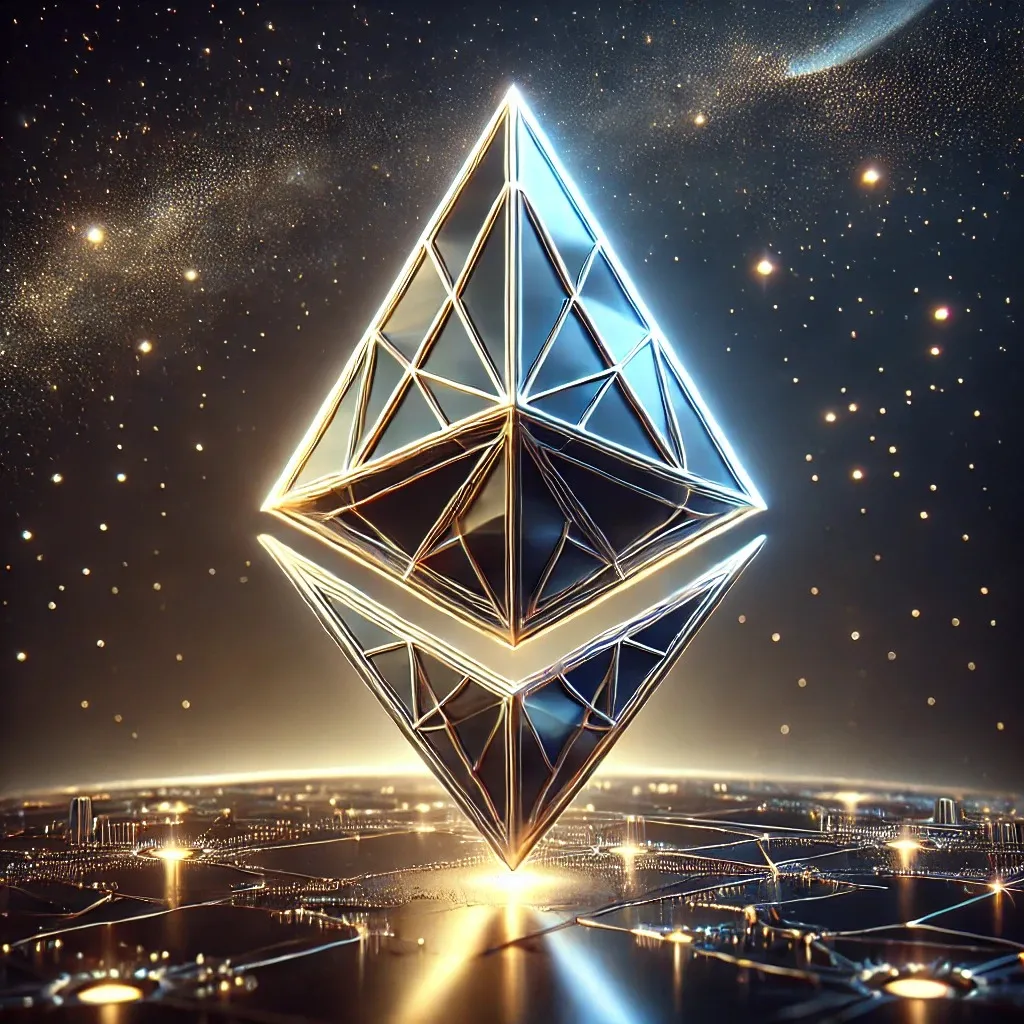
Ethereum (ETH) Price Prediction for 2025

Ethereum (ETH) maintains its position as one of the most significant cryptocurrencies on the market after bitcoin, offering users not just a digital asset, but a full-fledged platform for developing decentralized solutions. In 2025, investors and analysts are actively following ETH rate forecasts as the currency becomes an important part of the blockchain ecosystem. The value of Ethereum is influenced by many factors, including network updates and the economic, political environment.
In this article, we will take a detailed look at what influences the ETH rate, compare it to other cryptocurrencies, and discuss expert opinions.
Ethereum (ETH) - what kind of cryptocurrency is it?
Ethereum (ETH) is a decentralized blockchain-based platform that has its own coin and was created in 2015 by programmer Vitalik Buterin and his team. It differs significantly from other cryptocurrencies, including Bitcoin, due to its versatility and functionality. Ethereum not only serves as a digital currency, but also represents a complete ecosystem for the development and operation of smart contracts and decentralized applications (dApps).
Ethereum’s main characteristics:
- ETH Digital Currency: Ethereum is used to pay transaction fees (gas) and transactions on the platform. ETH also acts as a medium of accumulation and exchange like other cryptocurrencies.
- Smart Contracts: These are programmable agreements based on blockchain technology that guarantee the automatic execution of transaction terms without the need for intermediaries. These contracts have a wide range of applications in various fields, including financial transactions and supply chain management, helping to open up new opportunities for entrepreneurship and innovation.
- Proof of Stake (PoS) mechanism: This mechanism became the backbone of Ethereum’s operation after the transition from the originally used Proof of Work (PoW) in 2022 as part of the Ethereum 2.0 update. This innovation significantly increased the scalability of the network and reduced its energy costs, making it more resilient and efficient.
- Decentralized Applications (dApps): The Ethereum platform provides tools to create applications that run without central control. These applications find use in various fields such as finance (DeFi), art (NFT), gaming, and governance.
- Tokenization and NFT: Ethereum is used to create tokens of various standards, including the most popular ERC-20 for cryptocurrencies and ERC-721 for non-replaceable tokens (NFT), these standards open up new opportunities for investors, creators and companies.
What Ethereum was created for
Ethereum was conceived as a response to the key limitations of the first cryptocurrency, Bitcoin. While Bitcoin provides secure and decentralized transactions, it is not capable of more complex tasks such as automating processes or creating decentralized applications. The main goal of Ethereum is to create a universal platform that provides a wide range of programming and collaboration capabilities without the need for third parties.
The main goals of creating Ethereum are:
- Decentralization of services and applications: Vitalik Buterin and his team aimed to create a system that allows decentralized applications to run on the blockchain, which eliminates dependence on centralized servers and increases resistance to censorship and disruption.
- Creating smart contracts: Smart contracts are self-executing programs that automate the execution of transaction terms. Ethereum has allowed developers to create such contracts, which has greatly simplified many processes, including transactions, leases, insurance, and others.
- Expanded blockchain functionality: Unlike Bitcoin, Ethereum was designed as a platform to perform any programmable task. This has enabled a wide range of ideas, from games and social networking to complex financial instruments.
- Simplified token development and implementation: Ethereum has made it much easier to create your own token thanks to standards such as ERC-20 and ERC-721. This has made launching new cryptocurrencies and projects more accessible.
- Creating a DeFi (Decentralized Finance) ecosystem
a financial ecosystem where users can access credit, loans, staking and other services without traditional banks is one of Ethereum’s main goals.- Accessibility
developers of Ethereum sought to make the blockchain accessible to everyone regardless of geography, income level or political situation, giving millions of people a chance to take advantage of innovative technology and financial tools.Problems solved by Ethereum:
- Centralization: Traditional services run the risk of depending on central servers that are subject to failures and attacks. Ethereum eliminates this problem by distributing data among network participants.
- Transparency: The open architecture of the blockchain ensures that all transactions and smart contracts on Ethereum are transparent, which helps build user trust.
- Distrust between parties: Smart contracts eliminate the need for intermediaries, as the terms of transactions are executed automatically according to rules set in the code.
- Entry Challenges: Ethereum reduces the cost and technical barriers to launching blockchain projects, making the technology accessible to developers and companies of all sizes.
Ethereum and Bitcoin - how they differ

Although Ethereum and Bitcoin are two of the most popular cryptocurrencies, there are many differences in purpose, technology and functionality between them.
The key differences are:
1. Purpose of creation:
-
Bitcoin: Created as an alternative to traditional currencies for secure and transparent transactions.
-
Ethereum: Focused on interacting with smart contracts and developing decentralized applications.
2. Functionality:
-
Bitcoin: Limited to financial transactions.
-
Ethereum: Supports smart contracts, enabling automation of various processes and creation of dApps.
3. Consensus Algorithm:
-
Bitcoin: Uses PoW, which requires significant resources.
-
Ethereum: As of 2022, uses PoS, significantly reducing power consumption.
4. Transaction speed:
-
Bitcoin: Processes about 7 transactions per second.
-
Ethereum: Processes about 30 transactions per second, making it faster.
5. Number of Coins:
-
Bitcoin: Has a limit of 21 million coins.
-
Ethereum: Does not have a hard limit, but some coins are burned, introducing an element of scarcity.
6. Architecture and programming language:
-
Bitcoin: Written in C++, limited in functionality.
-
Ethereum: Built using Solidity, allowing more complex applications to be developed.
7. Real world applications:
-
Bitcoin: Used as a store of value.
-
Ethereum: Finds use in a variety of applications including DeFi, asset tokenization, and NFT.
8. Capitalization and popularity:
-
Bitcoin: The leader in terms of market capitalization.
-
Ethereum: In second place, standing out in innovation.
Ethereum capitalization as of today
At the beginning of 2025, the capitalization of Ethereum continues to grow steadily, occupying the second position after Bitcoin. This figure is determined by the level of demand, the number of active users and the general situation in the crypto market, and at the time of writing is 400 billion dollars.
Buying Ethereum by different funds
Large investment funds play a key role in shaping the demand and price of Ethereum. The interest from such organizations not only emphasizes confidence in the future of the cryptocurrency, but also stimulates its adaptation at the institutional level.
Why funds are buying Ethereum:
1. Portfolio diversification:
Cryptocurrencies, including Ethereum, have become an important part of many investment funds’ portfolios. ETH is attractive due to its versatility and growth prospects.
2. The rise of decentralized finance (DeFi):
Ethereum is the basis for most DeFi projects, making it a key asset for funds focused on innovative financial technology.
3. Popularity of smart contracts:
Ethereum is actively used in a variety of industries, from artificial intelligence to data management. This increases its long-term value, which attracts institutional investors.
4. Decrease in ETH issuance:
After the move to Proof of Stake (PoS) and the introduction of ETH burn mechanism, the supply has decreased, creating scarcity and increasing the attractiveness of the asset.
Major funds investing in Ethereum:
1. Grayscale Investments:
This is one of the largest cryptocurrency funds in the world. Grayscale offers investors the ability to buy shares of its Ethereum Trust (ETHE), which tracks the price of ETH. The fund reportedly owns millions of ETH, which underscores its confidence in the cryptocurrency’s future.
2. ARK Invest:
Managed by Katie Wood, the fund actively invests in innovative technologies, including cryptocurrencies. Ethereum features prominently in ARK Invest’s portfolio due to its key role in DeFi and NFT.
3. Fidelity Investments:
One of the largest traditional investment funds, Fidelity provides crypto-asset services to its clients. Ethereum is seen as a strategic asset for long-term investment.
4. Galaxy Digital:
The company, headed by Mike Novogratz, actively supports Ethereum by investing in projects based on it and acquiring ETH.
5. CoinShares:
This European fund provides tools to invest in Ethereum through its products such as ETPs (exchange traded products) linked to ETH.
6. MicroStrategy:
While MicroStrategy is better known for its investments in Bitcoin, the company has also expressed interest in Ethereum, especially given its functionality in business applications.
How fund purchases affect Ethereum:
1. Increased confidence:
Institutional investments are signaling to retail investors that Ethereum is a trustworthy asset.
2. Increased demand:
Mass fund purchases increase demand for ETH, which can lead to an increase in its value.
3. Decrease in available supply:
Institutional players often hold their assets long-term, which reduces the amount of ETH in free circulation.
4. Regulation and transparency:
Investing through funds makes the Ethereum market more accessible and transparent to traditional investors who prefer to bypass cryptocurrency exchanges.
Trump’s role on cryptocurrency predictions
While Donald Trump’s policies may seem far removed from cryptocurrencies, his statements and possible impact on regulation can change investor sentiment and influence the market.
Esterium predictions from opinion leaders
An important factor is that the dynamics of Bitcoin affect Ethereum. Experts share their opinions:
Analysts from Cryptoquant
believe that Ethereum could reach a new peak in 2025 due to declining issuance and growing interest in blockchain technology.
Kane Warwick, founder of Infinex
Expects Ethereum’s role in the DeFi space to strengthen and predicts its value to be above $10,000.
Gaia Regis, co-founder of Byzantine
Notes the impact of ETH staking in strengthening the network and the potential for its use in large corporations.
Saul Regvan, Managing Partner at Masterkey
Confident that institutional investment will be a key driver of growth.
Matt Hone, CEO of Bitwise
Believes that the popularization of Ethereum ETFs will push the price up.
Michael van de Poppe, Founder of MN Capital
Predicts that Ethereum will be less prone to volatility as its network becomes more mature.
Conclusion
Ethereum is well positioned to strengthen its market position thanks to the support of large investors, infrastructure development and growing interest in blockchain.
FAQ
1. How is Ethereum different from Bitcoin?
Ethereum has the ability to work with smart contracts and a platform for applications.
2. What factors influence the price of Ethereum?
Demand, capitalization, news, regulation and network development are important.
3. Is it possible to mine Ethereum in 2025?
After the transition to PoS, ETH mining is no longer available. Stacking is used instead.
4. How safe is it to invest in Ethereum?
There are risks, but the long-term outlook is positive when analyzing the market.
5. What is Ethereum’s outlook for 2030?
The technology has the potential for global integration, which could further increase the value of ETH.